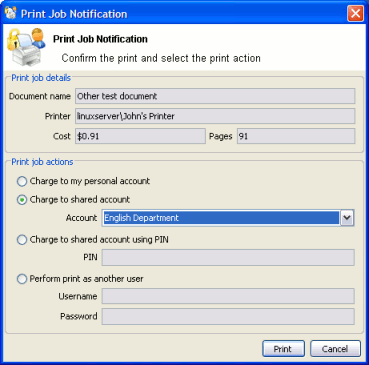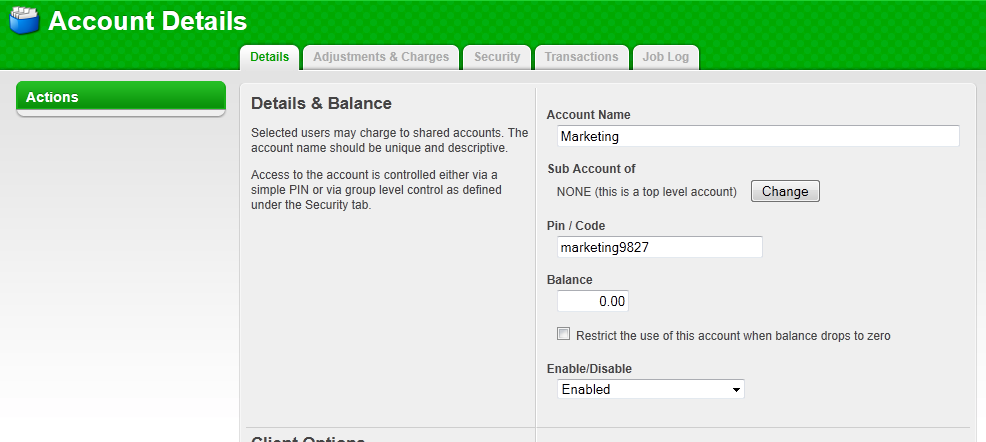Table of Contents
- Creating a Shared Account
- Account Naming Guidelines
- Client Security
- The Account Selection Popup
- Account Selection in Non-Domain Environments (Workgroups)
- Batch Shared Account Import and Update
- Shared Account Synchronization
- Bulk Shared Account Operations
- Shared Account Quota Allocation
- Shared Account Cost Multiplier
- Advanced Shared Account Options
PaperCut NG has two types of accounts - personal accounts and shared accounts. Each user has a personal account. This is the default account charged under normal operation. In some organizations and businesses it may be useful to provide users, or selected users with the option to charge printing to a shared account. Some uses of shared accounts include ...
In business:
Allocate and budget printing by business areas (e.g. cost center)
Track printing by project, phase, client or account
Track printing by client/matter - popular in legal and accounting firms
In a school or university:
Budget staff use via shared faculty or department accounts
Provide share accounts for classes or subjects
Track printing costs by subject areas
Shared account scenario
East Beach High School has implemented PaperCut NG to control their printing. Students are allocated a $5.00 a month budget. Pre-paid cards are sold at the library for students who need extra credit above this allowance.
Teachers and staff are given a small personal budget to cover casual printing with curriculum material to be allocated to share accounts. Shared accounts exist for each faculty. The network administrator has granted staff members access to the share account popup. Access to faculty accounts is controlled via Active Directory group membership.
Sarah is a Science and English teacher at the school. When she prints she is able to allocate the print job to either her personal account or either the Science or English shared account via a drop-down list. She can also view the shared accounts balances from the User web pages.
Tip
To educate the users about shared accounts, administrators might find the sample information sheet helpful.
Personal user accounts are automatically created when users are first imported into the system. Shared accounts are created manually on an as-need basis. Normally shared accounts are created manually via the administration interface, however organizations with many accounts and good IT skills can automate the account creation process by importing accounts. Import options include via a file (for example Excel, or an export from a 3rd party system) or by scanning an existing directory structure. More information on automatic importing can be found in the section called “Batch Shared Account Import and Update”.
To create a shared account:
Log into PaperCut NG as an administrator (e.g. admin account).
Select the Accounts tab.
Click the Create a new account action.
Enter an appropriate name for the account. Account names should be as descriptive as possible.
Complete other details such as starting balance, restrictions status and notes as appropriate.
Click the button to save the changes and return to the accounts list.
By default shared accounts default to an unrestricted status. This means that the account's balance is allowed to drop below zero. Many organizations use shared account to track printing expense. A common strategy is to start the account off at a zero balance and let it count down into the negative. By setting the account to restricted and allocating an initial starting balance, shared accounts can be used as a budget control system as printing to the account is denied once credit is exhausted.
Tip
PaperCut NG has support for advanced parent/child account structures. The subsequent account naming conventions section covers many of the common practices. See the section called “Account Naming Guidelines” for more details.
Each account can also be assigned a PIN/Code that helps uniquely identify an account. Many users use the codes to represent cost-centers, clients, projects, etc. These codes are often also used in other systems (like the accounting system) to identify these accounts consistently across the organization. Once defined, these codes can be used in the client software to quickly search for accounts, and can also displayed in account-based reports.
The account PIN/code can be entered on both parent and sub-accounts. For example, it is common to use parent accounts to represent clients and sub-accounts to represent projects for those clients. In this scenario, the parent account code would represent a client code, and the sub-account code would represent the project code.
The [Template Account] is designed to save time by applying the most common settings
to all newly created accounts. The [Template Account] can be found on the
Shared Account List page of the Accounts tab.
Any settings applied to the template account will be applied to new accounts when they are created.
Some examples of where the template account might prove useful include:
Applying common security settings. For example, if the
Staffgroup should have access to all accounts, adding the group to the template account will ensure group members can also charge to future accounts.Applying a starting balance. The starting balance might represent the standard department print quota or the amount of 'free printing' a customer has before they are billed for the excess.



